1847 Season
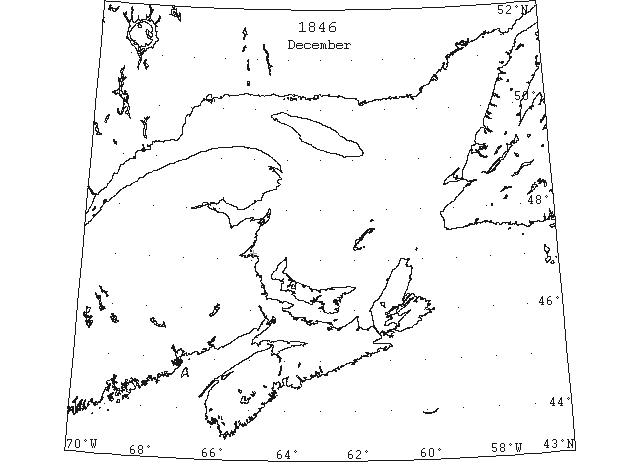
Dec 11 Entered: “Caledonia”, “Joseph” and “Elizabeth” from Pictou; “Ringdove” from Halifax. (PEI 11 Dec p3 c2)
Dec 18 Issue: Entered: Schooner “Caledonia” from Pictou on December 13; Schooner “Willing Lass” from St. John’s, NF on December 12; Schooner “Lady” of this town, bound for Miramichi… after making three attempts to reach that port, was obliged to return to Charlottetown, and has since discharged her cargo. (PEI 18 Dec p3 c2)
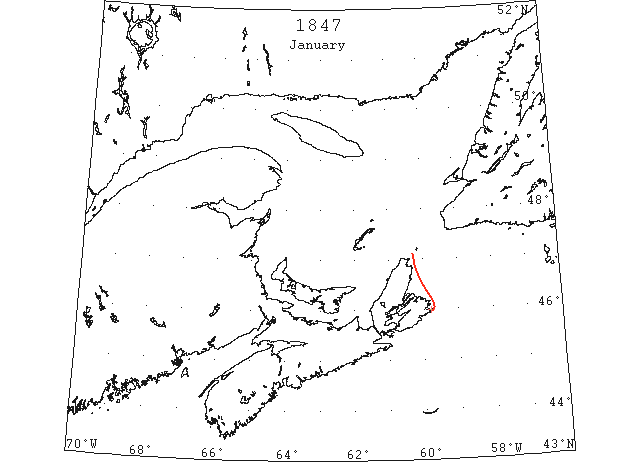
an 31 “Wreck of the “John Edmond” – On Sun. the 31st Jan. last, the schr “John Edmond” of Halifax, NS, Vincent, master, was lost on the “Balline Rock” of Main-a-dieu, towards the eastern coast of Cape Breton, the vessel and cargo a total loss. The circumstances attending this misfortune are truly lamentable, and are as follows : – The John Edmond sailed from Halifax on the15th Jan. with a general cargo for Rose Blanch on the Newfoundland coast, and after encountering almost every difficulty attending a voyage at this inclement season, she was driven off the land several times, between the Isle of Sable and Saint Paul’s – constant and changeable gales again drove this ill-fated vessel to the westward of Scatterie Island amongst ice and surrounded with fog. Under the greatest sufferings, at this crisis, the master and crew determined if possible to make the land, with the hope of saving their lives. Their fore boom was at this time carried away and the foremast sprung and the vessel unable to put to sea having become a solid mass of ice, every rope which might be useful, cracked from the intense cold – two of the crew were severely frozen; endeavoring to make Balline harbour the vessel struck on a sunken rock and immediately heeled over on her beam ends, when two or three heavy seas raised her off the rock and finally stranded her on a reef running off the easternmost point of the harbor about 3 or 4 hundred yards from the shore. The Captain having ascertained nearly where he was, endeavored to attract the notice of the inhabitants, who began to assemble on shore. The harbour was full of “lolly” and partly frozen over, so as to render the boat perfectly useless. Several attempts were made by the assembled crowd to afford relief to the sufferers on board, whose misery cannot be described by others, the vessel full of ice water, the hatches on a level with the water, and the intense cold caused every spot to become a solid mass of ice. In vain were the excretions of those on shore ; a Newfoundland dog endeavored to reach the vessel, urged on by his owner to go along side, with the hope of getting a line fast to him which might be serviceable – but having thrice made the attempt the noble animal reluctantly abandoned his purpose, owing to the heavy undertow and ice forming in the harbour. The anxious crew still bent on the hope of saving their lives, once more consulted their Captain, who with the owner of the of the cargo, Mr. John Quin, of Halifax, cheered the brave fellows to one more exertion. One of the crew, Dan Farrell, a native of Ireland, volunteered to reach the shore with a line, or perish in the attempt, saying at the time, “he would rather die or save his companions.” He took two small oars in his hand and crawled over the vessel’s side on the slender ice and lolly and aided by a Gracious Providence succeeded in reaching the shore much exhausted, amidst the cheers of the crew and their shore friends. The line he had with him was made fast to a stronger one, and hauled on board the “John Edmond” by those who were able , and two holes cut into the hatch, to which it was fastened, one end being made fat on board, while the party on shore hauled this contrivance to them each time bearing one of the crew, this plan lasted only a shore time, the line broke and Farrell again succeeded in making it fast to the ship : – to this means ever soul on board owes his safety. Mr. Quin suffered greatly from cold and fatigue, together with unparalleled exertions for life or death; he was quite exhausted when taken on shore. The Captain and Crew believed nobly, each anxious for the safety of his companion. The inhabitants of “Balline” afforded every assistance to the sufferers, who have lost almost every article of clothing. Mr. Quin, the Captain and Crew were kindly and hospitably lodged in the house of Mr. Robert Burk, to whom and his family they express their sincere thanks. Brave Farrell, will not his countrymen compliment him on his noble conduct? They certainly will. Recorder. (NS 22/02/1847 p59 #4)
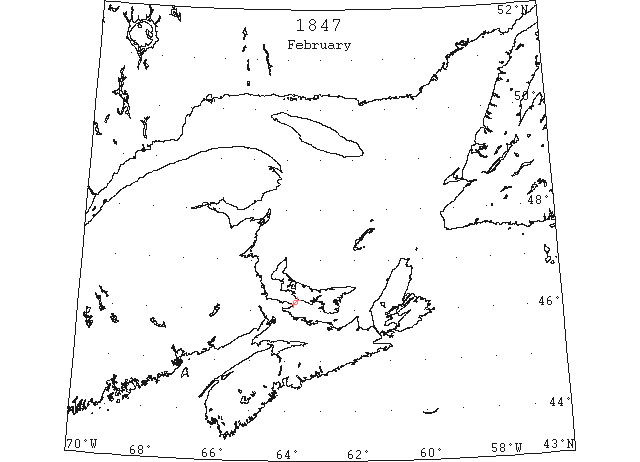
Feb 7 Passengers: in the ice boat on Monday from Cape Tormentine. (PEI 12 Feb p c4)
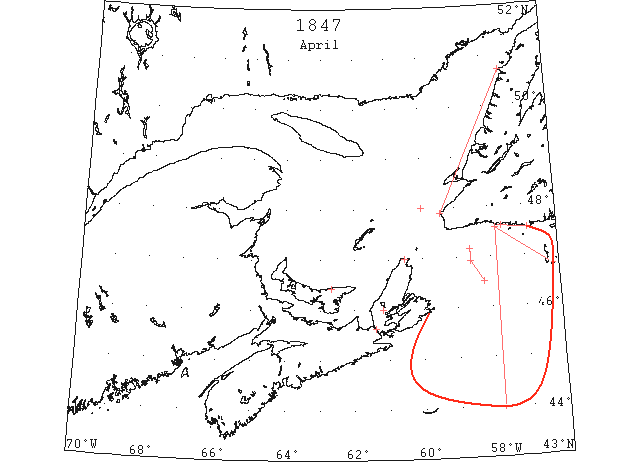
Apr 8 Ship “Albion” from Glasgow to Montreal 46°31’N 58°13’W made ice; 9th, 46°56’N 58°34’W grinding through ice; 10th, Ship fast in ice; 11th, pressing slowly through the ice; 12th, ice very heavy scarcely moving, 8 pm got out into open water about 40m from Cape Ray; 14th, put into Port aux Basques; 25th, left Port aux Basques; 26th, jammed in ice off Cape Anguille and drift up to Point Riche near entrance to Strait of Belle Isle and finally got out after a gale broke up the ice on May 24, arrived Quebec Jun 4, passage 70 days, detained by ice 46. (from extracts from log and Bryce Allan had also typed up this “historic” voyage. 4 vessels entered the ice together including the “Great Britain”, “Eromanga” and the “St.Andrew”. The “Belle Isle” was with “Albion” on the drift up to Belle Isle. (#575)
Apr 9 Launched at St. Peter’s Bay, on Tuesday the 6th of April… a brigantine of 130 tons, called the “Cleopatra”. This fine vessel was hauled a distance of 200 yards on the ice, by the united strength of about 60 horses. (PEI 9 Apr p3 c3)
Apr 14 We learn from the Exchange Register that a letter has been received here from Captain Bayfield, dated Prince Edward Island, 14th instant, in which he states that the quantity of ice in the Gulf, opposite Charlotte-Town, is greater than has ever been known before at that time of year: it is completely covered with ice. (QG #6651 30/04/1847 P3, Col2C)
Apr 21 Jersey Harbour, Newfoundland: The “Iris” arrived from Jersey was prevented by ice from going further west than 57°49’W; from that point she proceeded southward to 44°N from which she again proceeded northward to 47°35’N and saw Cape La Hune, but could not discover any passage; the ice was fast to Miquelon, southward of the Seal Rocks – she fell in with the first ice 150m east of the Great Bank, which she crossed in 43°55’N; she put into St.Peter, where it was reported that a brig from the West Indies to La Poile, supposed to be the “Harmony” had been hard and fast in the ice, between Cape La Hune and Burgeo, with the channel all to pieces. A craft here 16th inst. from Lamelin reports one of Messrs. Falles’ vessels hard and fast in the ice. (LL).
Apr25-29 “Sophia Moffatt” for Quebec with bowsprit stove in by ice and leaking badly was passed 25th ult. in 46°N [48°?] 60°W by the “Cambria”, arrived here. The “Emma Searle” also in the ice, was passed by her the same day. The “Canada” was seen in the ice off Cape North 29th ult. by the “Coeur de Lion”, arrived here. (LL 10 May)
Apr 28 Gut of Canso closed with ice. (LL).
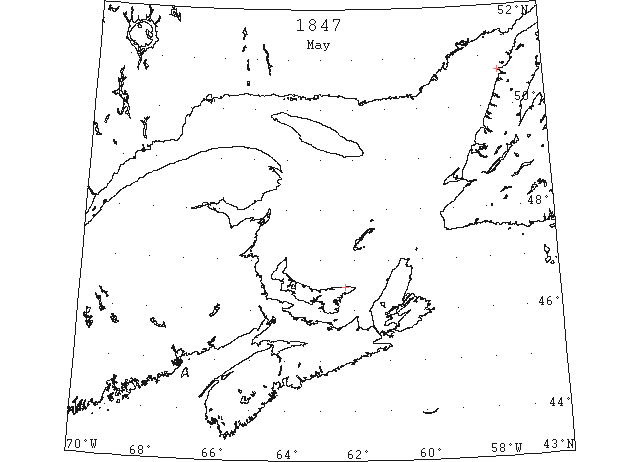
May 1 Quebec: The quantity of ice opposite Charlotte Town is greater than has ever been known at this period of year. (LL).
May 10 “Sophia Moffatt” for Quebec with bowsprit stove in by ice and leaking badly was passed 25th ult. in 46°N 60°W by the “Cambria”, arrived here. The “Emma Searle” also in the ice, was passed by her the same day. The “Canada” was seen in the ice off Cape North 29th ult. by the “Coeur de Lion”, arrived here. (LL)
May 10 Thomas Irwin – better known as a writer of the micrean language – was found dead on the sea ice off Big Pond, Lot 45, on Wednesday the 10th of May. He had been missing for several weeks, and was accidentally found by some young men who had strolled out on the ice, a distance of three quarters of a mile from the shore. (PEI 14 May p5 c4)
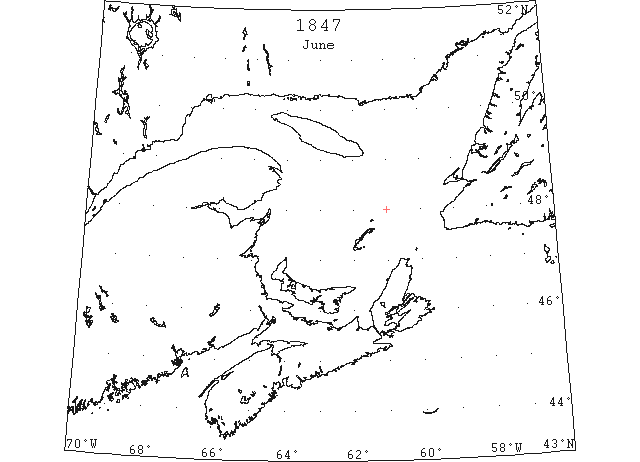
Jun 4 Greenock: The “Caledonia” from the Clyde to Montreal was seen in the ice in the Gulf of St. Lawrence by the “Britannia” arrived at Quebec. (LL).